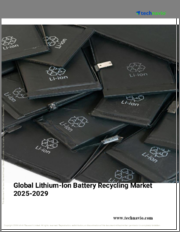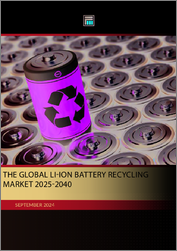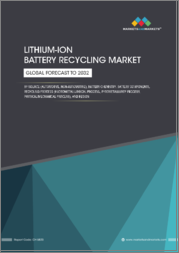
|
시장보고서
상품코드
1620552
리튬 이온 배터리 재활용 시장 기회, 성장 촉진요인, 산업 동향 분석 및 예측(2024-2032년)Lithium-Ion Battery Recycling Market Opportunity, Growth Drivers, Industry Trend Analysis, and Forecast 2024 to 2032 |
||||||
세계 리튬 이온 배터리 재활용 시장은 2023년 54억 달러에 달했고, 2024-2032년간 연평균 20.6%의 성장률을 나타낼 것으로 전망됩니다. 이 시장에는 사용되거나 폐기된 리튬 이온 배터리에서 리튬, 코발트, 니켈 및 기타 금속을 포함한 귀중한 물질을 회수하는 것이 포함됩니다. 이 배터리는 소비자 전자제품, 전기자동차(EV), 재생에너지 저장 시스템 등 다양한 응용 분야에서 일반적으로 사용되고 있습니다. 재활용 공정은 배터리의 회수, 선별, 분해, 물리적, 습식 야금 또는 건식 야금 방법을 통한 유가 원소 추출 등 몇 가지 중요한 단계로 구성됩니다. 리튬 이온 배터리의 부적절한 폐기로 인한 환경 영향에 대한 인식이 높아짐에 따라 유해 물질의 누출로 이어질 수 있으므로 재활용 프로세스의 채택을 촉진하고 있습니다.
특히 전기자동차의 보급과 함께 중요한 원자재에 대한 수요가 지속적으로 증가함에 따라 재활용의 필요성이 점점 더 커지고 있습니다. 또한 제조업체들은 보다 안정적이고 덜 취약한 공급망을 구축하기 위해 사용한 배터리에서 귀중한 금속을 회수하기 위한 투자를 늘리고 있으며, 이는 산업의 성장을 더욱 촉진하고 있습니다. 공급원별로는 주로 전기자동차로의 전환과 탄소 배출량 감축을 위한 세계 노력으로 인해 자동차 부문은 2032년까지 170억 달러 이상에 달할 것으로 예상됩니다. 배터리 재활용을 촉진하기 위해 각국 정부 및 규제 기관이 보다 엄격한 환경 정책을 시행하고 있는 것도 수요를 증가시킬 것입니다. 자동차 제조업체들이 사용한 배터리의 적절한 폐기 및 재활용을 의무화하는 것은 이러한 추세를 가속화할 것으로 예상됩니다.
화학 분야에서는 리튬 니켈 망간 코발트 산화물(NMC) 부문이 2032년까지 연평균 19.5% 이상의 성장률을 보일 것으로 예상됩니다. 이러한 성장은 NMC 배터리에 포함된 중요한 재료의 높은 비율로 인해 환경에 유해한 채굴 방식에 대한 의존도를 줄이는 동시에 EV 및 에너지 저장에 필수적인 우수한 에너지 밀도, 긴 사이클 수명, 안정적인 열 성능을 갖춘 배터리에 대한 경제적 이점이 있기 때문입니다. 수요 증가는 NMC 기술의 채택을 더욱 촉진할 것입니다. 아시아태평양의 리튬 이온 배터리 재활용 시장은 2032년까지 140억 달러 이상에 달할 것으로 예상됩니다. 정부의 장려책에 힘입어 전기자동차 및 소비자 전자제품의 급속한 성장이 산업 발전을 촉진할 것으로 보입니다.
| 시장 범위 | |
|---|---|
| 시작 연도 | 2023년 |
| 예측 연도 | 2024-2032년 |
| 시작 금액 | 54억 달러 |
| 예상 금액 | 320억 달러 |
| CAGR | 20.6% |
배터리 재활용 네트워크와 확대된 생산자책임재활용(EPR)을 준수하도록 하는 규제 강화는 시장 확대의 큰 기회를 창출할 것으로 보입니다. 이 지역은 증가하는 배터리 제조 수요를 충족시키기 위해 수입 원료에 계속 의존하고 있기 때문에 이러한 중요한 자원의 채굴에 대한 의존도를 줄이기 위해 재활용에 초점을 맞추는 움직임이 강화될 것으로 보입니다.
목차
제1장 조사 방법과 조사 범위
제2장 주요 요약
제3장 산업 인사이트
- 산업 에코시스템
- 규제 상황
- 산업에 대한 영향요인
- 성장 촉진요인
- 산업의 잠재적 리스크와 과제
- 성장 가능성 분석
- Porter's Five Forces 분석
- PESTEL 분석
제4장 경쟁 구도
- 서론
- 전략 대시보드
- 혁신과 기술 전망
제5장 시장 규모와 예측 : 화학제품별, 2021-2032년
- 주요 동향
- 니켈 망간·코발트산리튬(NMC)
- 인산철리튬(LFP)
- 코발트산리튬(LCO)
- 기타
제6장 시장 규모와 예측 : 프로세스별, 2021-2032년
- 주요 동향
- 건식제련
- 습식 야금
- 물리적/기계적
제7장 시장 규모와 예측 : 공급원별, 2021-2032년
- 주요 동향
- 자동차
- 비자동차
제8장 시장 규모와 예측 : 지역별, 2021-2032년
- 주요 동향
- 북미
- 미국
- 캐나다
- 유럽
- 영국
- 프랑스
- 벨기에
- 스위스
- 독일
- 아시아태평양
- 중국
- 한국
- 일본
- 기타
제9장 기업 개요
- 3R Recycler
- ACE Green Recycling
- American Battery Technology Company
- Attero Recycling
- BatX Energies
- Cirba Solution
- Ganfeng Lithium
- Glencore
- Li-Cycle Holdings Corporation
- Lohum Cleantech
- Neometals
- RecycLiCo Battery Material
- Redwood Materials
- SK TES
- Umicore
The Global Lithium-Ion Battery Recycling Market reached USD 5.4 billion in 2023 and is projected to expand at 20.6% CAGR from 2024 to 2032. This market encompasses the recovery of valuable materials, including lithium, cobalt, nickel, and other metals, from used or discarded lithium-ion batteries. These batteries are commonly utilized in various applications, such as consumer electronics, electric vehicles (EVs), and renewable energy storage systems. The recycling process consists of several key stages, including battery collection, sorting, disassembly, and the extraction of valuable elements through physical, hydrometallurgical, or pyrometallurgical methods. Increasing awareness of the environmental impact caused by improper disposal of lithium-ion batteries, which can lead to leaks of hazardous materials, is driving the adoption of recycling processes.
As the demand for critical raw materials continues to rise-particularly in light of the growing popularity of electric vehicles-the need for recycling is becoming more urgent. Moreover, manufacturers are increasingly investing in recovering valuable metals from used batteries to establish a more stable and less vulnerable supply chain, further boosting industry growth. By source, the automotive segment is anticipated to exceed USD 17 billion by 2032, primarily due to the shift toward electric vehicles and the global initiative to reduce carbon emissions. The implementation of stricter environmental policies by governments and regulatory agencies worldwide to promote battery recycling will also enhance demand.Mandates requiring automakers to ensure proper disposal or recycling of used batteries are expected to accelerate this trend.
Regarding chemistry, the lithium nickel manganese cobalt oxide (NMC) segment is projected to grow at a CAGR of over 19.5% through 2032. This growth can be attributed to the high proportion of critical materials in NMC batteries, which presents significant economic advantages while reducing dependence on environmentally damaging mining practices. The increasing demand for batteries with excellent energy density, long cycle life, and stable thermal performance-essential for EVs and energy storage-will further promote the adoption of NMC technology. In the Asia-Pacific region, the lithium-ion battery recycling market is expected to surpass USD 14 billion by 2032. The rapid growth of electric vehicles and consumer electronics, supported by government incentives, will bolster industry development.
| Market Scope | |
|---|---|
| Start Year | 2023 |
| Forecast Year | 2024-2032 |
| Start Value | $5.4 Billion |
| Forecast Value | $32 Billion |
| CAGR | 20.6% |
Stricter regulations mandating battery recycling networks and compliance with extended producer responsibility (EPR) will create substantial opportunities for market expansion. As the region continues to rely on imported raw materials to satisfy increasing battery manufacturing demands, the focus on recycling will intensify, aiming to reduce dependence on mining these critical resources.
Table of Contents
Chapter 1 Methodology & Scope
- 1.1 Market definitions
- 1.2 Base estimates & calculations
- 1.3 Forecast calculation
- 1.4 Primary research & validation
- 1.4.1 Primary sources
- 1.4.2 Data mining sources
- 1.5 Market definitions
Chapter 2 Executive Summary
- 2.1 Industry 360° synopsis, 2021 - 2032
Chapter 3 Industry Insights
- 3.1 Industry ecosystem
- 3.2 Regulatory landscape
- 3.3 Industry impact forces
- 3.3.1 Growth drivers
- 3.3.2 Industry pitfalls & challenges
- 3.4 Growth potential analysis
- 3.5 Porter's analysis
- 3.5.1 Bargaining power of suppliers
- 3.5.2 Bargaining power of buyers
- 3.5.3 Threat of new entrants
- 3.5.4 Threat of substitutes
- 3.6 PESTEL analysis
Chapter 4 Competitive landscape, 2024
- 4.1 Introduction
- 4.2 Strategic dashboard
- 4.3 Innovation & technology landscape
Chapter 5 Market Size and Forecast, By Chemistry, 2021 - 2032 (USD Billion & Tons)
- 5.1 Key trends
- 5.2 Lithium nickel manganese cobalt oxide (NMC)
- 5.3 Lithium iron phosphate (LFP)
- 5.4 Lithium cobalt oxide (LCO)
- 5.5 Others
Chapter 6 Market Size and Forecast, By Process, 2021 - 2032 (USD Billion & Tons)
- 6.1 Key trends
- 6.2 Pyrometallurgical
- 6.3 Hydrometallurgical
- 6.4 Physical/Mechanical
Chapter 7 Market Size and Forecast, By Source, 2021 - 2032 (USD Billion & Tons)
- 7.1 Key trends
- 7.2 Automotive
- 7.3 Non-Automotive
Chapter 8 Market Size and Forecast, By Region, 2021 - 2032 (USD Billion & Tons)
- 8.1 Key trends
- 8.2 North America
- 8.2.1 U.S.
- 8.2.2 Canada
- 8.3 Europe
- 8.3.1 UK
- 8.3.2 France
- 8.3.3 Belgium
- 8.3.4 Switzerland
- 8.3.5 Germany
- 8.4 Asia Pacific
- 8.4.1 China
- 8.4.2 South Korea
- 8.4.3 Japan
- 8.5 Rest of World
Chapter 9 Company Profiles
- 9.1 3R Recycler
- 9.2 ACE Green Recycling
- 9.3 American Battery Technology Company
- 9.4 Attero Recycling
- 9.5 BatX Energies
- 9.6 Cirba Solution
- 9.7 Ganfeng Lithium
- 9.8 Glencore
- 9.9 Li-Cycle Holdings Corporation
- 9.10 Lohum Cleantech
- 9.11 Neometals
- 9.12 RecycLiCo Battery Material
- 9.13 Redwood Materials
- 9.14 SK TES
- 9.15 Umicore



















